- Home
- About Us
- Industry
- Services
- Reading
- Contact Us
Laser Skin Resurfacing Market: Current Analysis and Forecast (2024-2032)
Emphasis on Type (Ablative and Non-Ablative); Application (Wrinkles & Scars, Aging Hands, Sagging Skin, and Others), End-Users (Specialty & Dermatology Clinics, Hospitals, and Others); and Region/Country
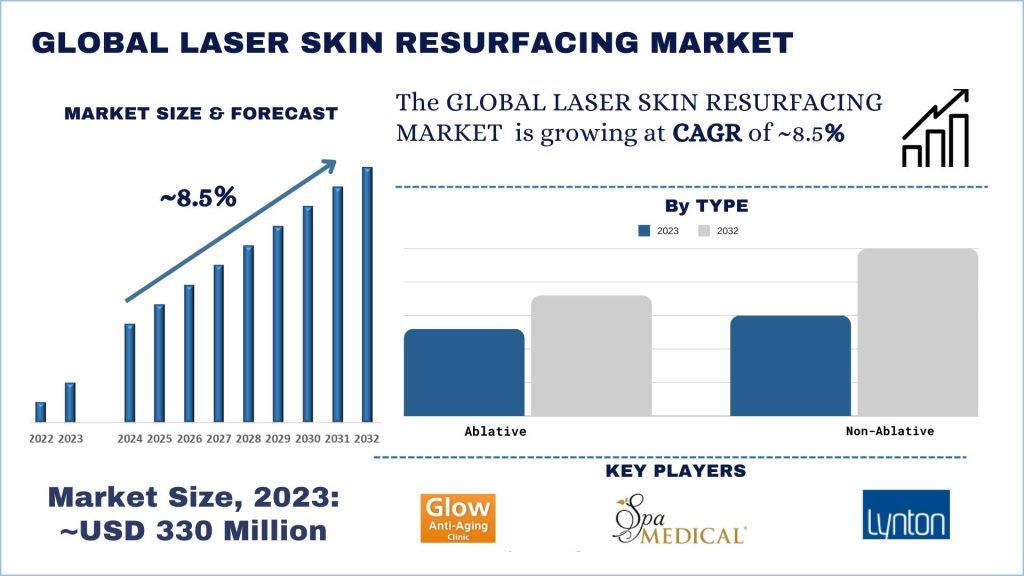
Laser Skin Resurfacing Market Size & Forecast
The Laser Skin Resurfacing Market was valued at approximately USD 330 Million in 2023 and is expected to grow at a strong CAGR of around 8.5% during the forecast period (2024-2032) owing to the rising trend of cosmetic makeovers.
Laser Skin Resurfacing Market Analysis
Laser skin resurfacing is an invasive cosmetic procedure aimed at improving skin quality through treating defects like wrinkles, scars, and uneven pigmentation. In this treatment, a high-energy density laser is used to vaporize the unhealthy portion of the skin and encourage the formation of new skin cells. Finally, it provides an easy procedure that can be used by anyone who wishes to improve the texture and color of their skin without having to go under the knife. Because laser skin resurfacing addresses skin conditions selectively, it has gained popularity as a treatment that can give people youthful and glowing skin. The Laser Skin Resurfacing market has tremendous growth potential worldwide, provided by the large number of potential consumers, increased awareness of the topic, and major technological innovations. The Laser Skin Resurfacing market is experiencing steady growth in the vulnerable and particularly important segment of the population, the elderly.
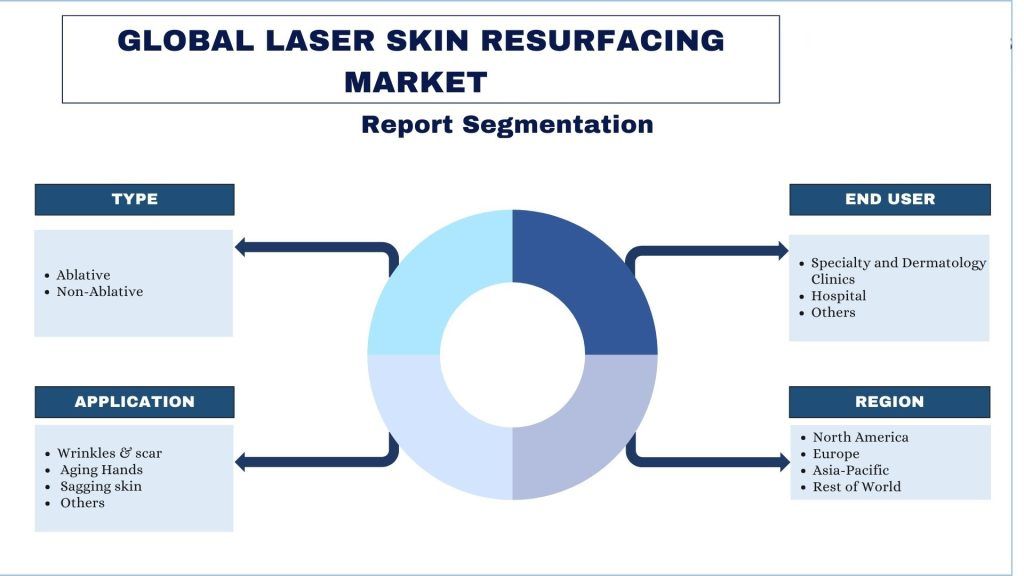
For instance, as per the data of WHO, in 2019, the elderly population (60+ years age) was 1 billion, which is expected to reach 1.4 billion by 2030 and 2.1 billion by 2050.
For instance, as per the data of American Society of Plastic Surgeons, nearly 600,000 laser resurfacing procedures are performed each year in the U.S.
Laser Skin Resurfacing Market Trends
This section discusses the key market trends that are influencing the various segments of the Laser Skin Resurfacing Market as identified by our team of research experts.
Increasing Demand Among Younger Patients
In the past Laser Skin Resurfacing was most often found among people in the third age, wishing to get rid of the changes associated with aging like wrinkles or scars. However, more and more young people resort to laser Skin resurfacing. Causes for this shift include the growing demand for aesthetic treatment, the effects of social media, and the advancements in the prevention of aging. The so-called millennials are now coming for surgery simply wanting to look younger and not necessarily waiting for symptoms of early aging to develop into full-blown surgery indications.
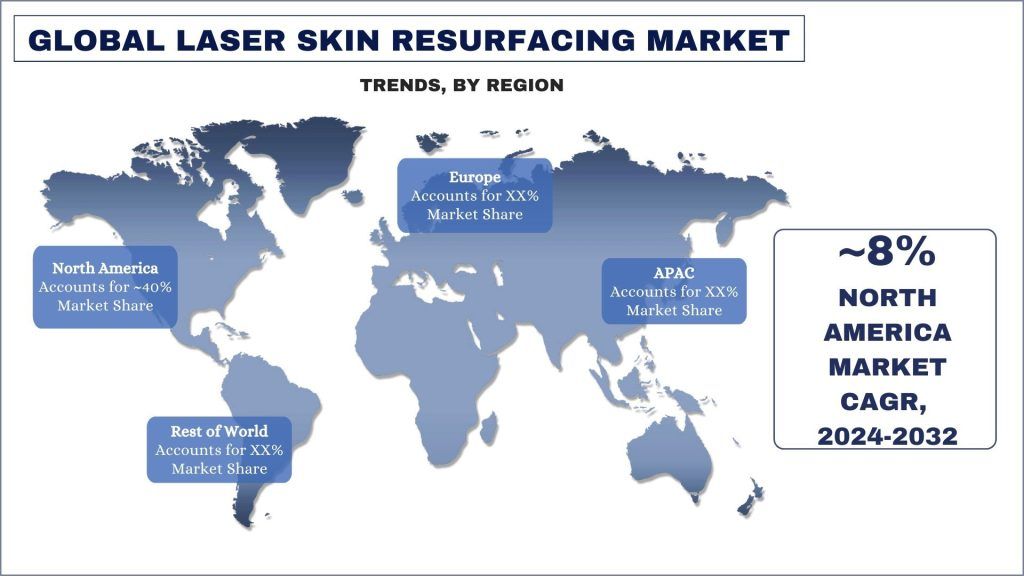
North America is Expected to Grow with Significant CAGR During Forecast Period
The Laser Skin Resurfacing Market in North America has experienced significant growth in recent years, driven by various factors. North America, particularly the U.S., represents one of the largest markets for Laser Skin Resurfacing globally. One of the primary drivers of the Laser Skin Resurfacing market in North America is the aging population. According to the U.S. Census Bureau, the number of Americans aged 65 and older is projected to nearly double by 2060, reaching approximately 95 million. This demographic shift results in a higher demand for cosmetic procedures that can reduce the visible signs of aging, such as Laser Skin Resurfacing.
Laser Skin Resurfacing Industry Overview
The Laser Skin Resurfacing Market is competitive, with the presence of several global and international market players. The key players are adopting different growth strategies to enhance their market presence, such as partnerships, agreements, collaborations, new product launches, geographical expansions, and mergers and acquisitions. Some of the major players operating in the market are Glow Anti-Aging Clinic, SpaMedical, Lynton Lasers Ltd, Elan aesthetics Inc, Venus Treatments, Estique clinic, Cutis Dermatology, Pure Luxe Medical, Alma Laser, Inc, and Aesthetic Solutions Inc.
Laser Skin Resurfacing Market Report Coverage
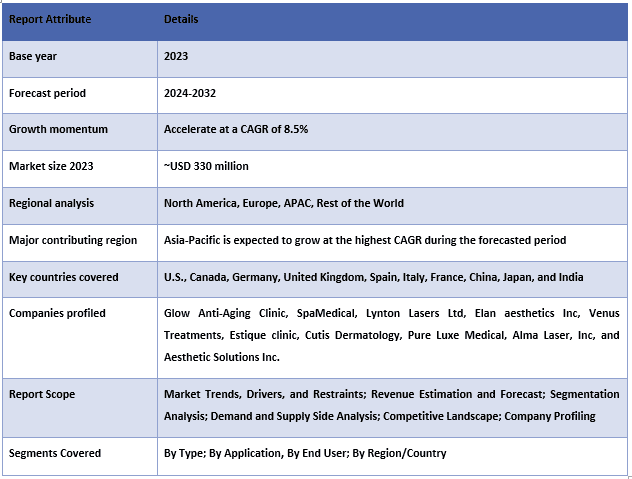
Reasons to buy this report:
- The study includes market sizing and forecasting analysis validated by authenticated key industry experts.
- The report presents a quick review of overall industry performance at one glance.
- The report covers an in-depth analysis of prominent industry peers with a primary focus on key business financials, product portfolios, expansion strategies, and recent developments.
- Detailed examination of drivers, restraints, key trends, and opportunities prevailing in the industry.
- The study comprehensively covers the market across different segments.
- Deep dive regional level analysis of the industry.
Customization Options:
The Global Laser Skin Resurfacing Market can further be customized as per the requirement or any other market segment. Besides this, UMI understands that you may have your own business needs, hence feel free to connect with us to get a report that completely suits your requirements.
Table of Content
Research Methodology for the Laser Skin Resurfacing Market Analysis (2024-2032)
Analyzing the historical market, estimating the current market, and forecasting the future market of the global Laser Skin Resurfacing market were the three major steps undertaken to create and analyze the adoption of Laser Skin Resurfacing in major regions globally. Exhaustive secondary research was conducted to collect the historical market numbers and estimate the current market size. Secondly, to validate these insights, numerous findings and assumptions were taken into consideration. Moreover, exhaustive primary interviews were also conducted, with industry experts across the value chain of the global Laser Skin Resurfacing market. Post assumption and validation of market numbers through primary interviews, we employed a top-down/bottom-up approach to forecasting the complete market size. Thereafter, market breakdown and data triangulation methods were adopted to estimate and analyze the market size of segments and sub-segments of the industry pertains to. Detailed methodology is explained below:
Analysis of Historical Market Size
Step 1: In-Depth Study of Secondary Sources:
Detail secondary study was conducted to obtain the historical market size of the Laser Skin Resurfacing market through company internal sources such as annual reports & financial statements, performance presentations, press releases, etc., and external sources including journals, news & articles, government publications, competitor publications, sector reports, third-party database, and other credible publications.
Step 2: Market Segmentation:
After obtaining the historical market size of the Laser Skin Resurfacing market, we conducted a detailed secondary analysis to gather historical market insights and share for different segments & sub-segments for major regions. Major segments are included in the report as type, application, end-user and regions. Further country-level analyses were conducted to evaluate the overall adoption of testing models in that region.
Step 3: Factor Analysis:
After acquiring the historical market size of different segments and sub-segments, we conducted a detailed factor analysis to estimate the current market size of the Laser Skin Resurfacing market. Further, we conducted factor analysis using dependent and independent variables such as type, application, end-user and regions of the Laser Skin Resurfacing market. A thorough analysis was conducted for demand and supply-side scenarios considering top partnerships, mergers and acquisitions, business expansion, and product launches in the Laser Skin Resurfacing market sector across the globe.
Current Market Size Estimate & Forecast
Current Market Sizing: Based on actionable insights from the above 3 steps, we arrived at the current market size, key players in the global Laser Skin Resurfacing market, and market shares of the segments. All the required percentage shares split, and market breakdowns were determined using the above-mentioned secondary approach and were verified through primary interviews.
Estimation & Forecasting: For market estimation and forecast, weights were assigned to different factors including drivers & trends, restraints, and opportunities available for the stakeholders. After analyzing these factors, relevant forecasting techniques i.e., the top-down/bottom-up approach were applied to arrive at the market forecast for 2032 for different segments and sub-segments across the major markets globally. The research methodology adopted to estimate the market size encompasses:
- The industry’s market size, in terms of revenue (USD) and the adoption rate of the Laser Skin Resurfacing market across the major markets domestically
- All percentage shares, splits, and breakdowns of market segments and sub-segments
- Key players in the global Laser Skin Resurfacing market in terms of products offered. Also, the growth strategies adopted by these players to compete in the fast-growing market.
Market Size and Share Validation
Primary Research: In-depth interviews were conducted with the Key Opinion Leaders (KOLs) including Top Level Executives (CXO/VPs, Sales Head, Marketing Head, Operational Head, Regional Head, Country Head, etc.) across major regions. Primary research findings were then summarized, and statistical analysis was performed to prove the stated hypothesis. Inputs from primary research were consolidated with secondary findings, hence turning information into actionable insights.
Split of Primary Participants in Different Regions
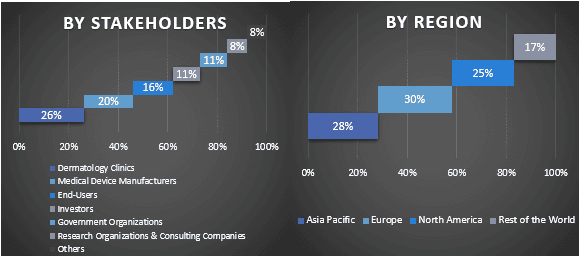
Market Engineering
The data triangulation technique was employed to complete the overall market estimation and to arrive at precise statistical numbers for each segment and sub-segment of the global Laser Skin Resurfacing market. Data was split into several segments & sub-segments post studying various parameters and trends in the areas of the Type, application, end-user and regions in the global Laser Skin Resurfacing market.
The main objective of the Global Laser Skin Resurfacing Market Study
The current & future market trends of the global Laser Skin Resurfacing market were pinpointed in the study. Investors can gain strategic insights to base their discretion for investments on the qualitative and quantitative analysis performed in the study. Current and future market trends determined the overall attractiveness of the market at a regional level, providing a platform for the industrial participant to exploit the untapped market to benefit from a first-mover advantage. Other quantitative goals of the studies include:
- Analyze the current and forecast market size of the Laser Skin Resurfacing market in terms of value (USD). Also, analyze the current and forecast market size of different segments and sub-segments.
- Segments in the study include areas of the Type, application, end-user and regions.
- Define and analyze the regulatory framework for the Laser Skin Resurfacing
- Analyze the value chain involved with the presence of various intermediaries, along with analyzing customer and competitor behaviors of the industry.
- Analyze the current and forecast market size of the Laser Skin Resurfacing market for the major region.
- Major countries of regions studied in the report include Asia Pacific, Europe, North America, and the Rest of the World
- Company profiles of the Laser Skin Resurfacing market and the growth strategies adopted by the market players to sustain in the fast-growing market.
- Deep dive regional level analysis of the industry
Frequently Asked Questions FAQs
Q1: What is the Laser Skin Resurfacing market's current market size and growth potential?
Q2: What are the driving factors for the growth of the Laser Skin Resurfacing market?
Q3: Which segment has the largest share of the Laser Skin Resurfacing market by type?
Q4: What are the emerging technologies and trends in the Laser Skin Resurfacing market?
Q5: Which region will dominate the Laser Skin Resurfacing market?
Related Reports
Customers who bought this item also bought










